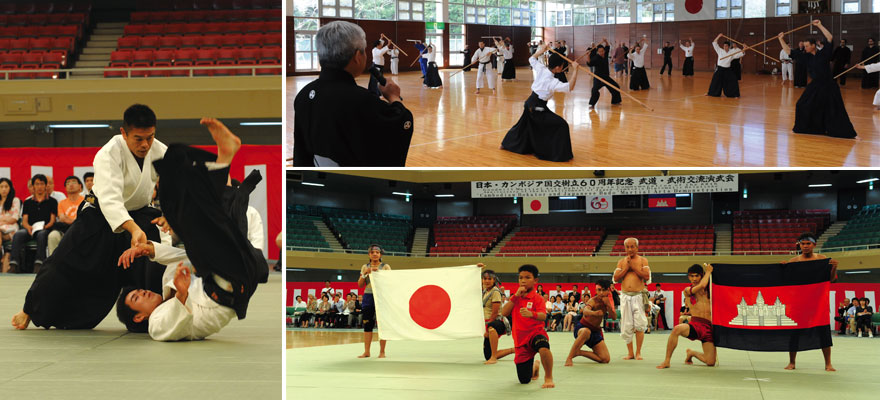Home > Highlighting JAPAN > Highlighting Japan October 2013 >Japanese Globalization
Highlighting JAPAN
Japanese Globalization
Nippon Budōkan
Mount Fuji in art and culture

THE history of Nippon Budōkan is one of international exchange." So says Mr. Yoshio Mifuji, the Secretary General. Completed in 1964 for the Tokyo Olympics of the same year, Nippon Budōkan incorporates some unique elements into its design. The roof mirrors the shape of Mount Fuji, while the support of the structure is provided by four internal columns that imitate the construction of a traditional sumo ring.
The main aim in the foundation of Nippon Budōkan is educating the healthy youth of Japan and "provide a place to cultivate international exchange through Budō."
One such example is the International Seminar of Budō Culture, now in its 25th year, held annually at the Nippon Budōkan Training Center and Budō International University. The 4-day course is open to foreign practitioners living in Japan and offers classes about the history and philosophy of Budō, as well as practical experience such as, kyudō (archery), aikidō, kendō, karate, shorinji kempō, sumo, jūdō, naginata (halberd), and jōdō (staff).
Each year, the Japanese Budō delegation, a group composed of 70 or so high level teachers, visits an overseas country to demonstrate martial arts and deepen international friendship and understanding. In November 2012, a demonstration was held in New Delhi, India that attracted as many as 6,300 spectators. 2013 has seen the 60th anniversary of international relations between Cambodia and Japan with practitioners from both countries participating in a joint demonstration, this time at the Budōkan.
Mifuji believes that Budō training has a strong demand internationally because of the very practical problem that it solves, "how to defend yourself without seriously hurting yourself or an opponent." Yet Budō does not end here. It is also a discipline that can be transmitted without the need for words, a universal "language of the body" as Mifuji describes it. Of course, language may be required in communicating some of the inner teachings of Budō. Meditation, an important component of training, helps practitioners free their minds from distracting thoughts or zatsunen, and focus on what is important. The ability to dispel stress and pent up emotions through meditation and breathing exercises may have a strong application in our modern societies.
Mifuji says that "so much emphasis is placed on giving the right answer in school and not on teamwork, yet working in a group and solving problems together can lead to great success. In Budō, there are many paths; it is not the path that is 'right' but the way one walks a path and finding one's goal."
With 5,000,000 Budō practitioners in Japan and a further 50,000,000 worldwide, Budō has a bright domestic and international future. If you're looking for better health, a better life and spending an enjoyable time with others, why not try looking up your local dōjō? In any case, it is a great achievement that organizations such as Nippon Budōkan have now become an international vehicle for greater cultural exchange, mutual understanding and peace.
© 2009 Cabinet Office, Government of Japan






